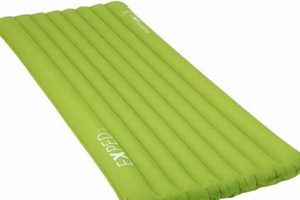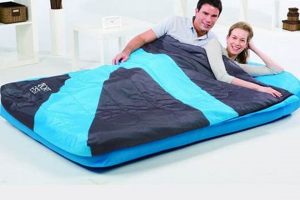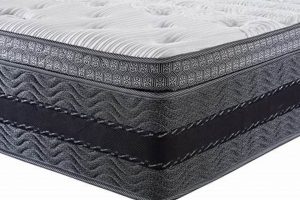A sleeping surface specifically designed for placement directly on the ground, rather than on a bed frame or foundation, offers a firm and stable platform. This type of bedding aims to provide support and comfort while mitigating the potential issues associated with direct contact between a conventional mattress and the floor. Examples include foldable mattresses, futons, and specialized foam constructions.
Utilizing a ground-level sleep arrangement can offer advantages related to spinal alignment, temperature regulation, and space optimization. Historically, floor sleeping has been practiced in various cultures, often linked to minimalism, improved posture, and a connection to natural elements. The practice potentially minimizes dust mite exposure and eliminates the need for additional furniture, thereby simplifying living spaces.
The following sections will delve into various considerations for choosing an appropriate ground-level sleeping surface, including material selection, support characteristics, hygiene maintenance, and suitability for different individual needs and preferences. These factors are critical for ensuring a comfortable and healthy sleep environment when forgoing a traditional bed setup.
Considerations for Ground-Level Bedding
Optimizing a sleep environment at floor level requires careful attention to several key factors to ensure both comfort and hygiene.
Tip 1: Material Selection: Opt for materials that are breathable and resistant to moisture buildup. Natural fibers like cotton, wool, or latex promote airflow and reduce the risk of mold or mildew growth beneath the sleeping surface.
Tip 2: Thickness and Support: Choose a sufficient thickness to provide adequate cushioning and support for the body. A minimum of 4 inches is generally recommended, with denser materials offering better pressure relief and spinal alignment.
Tip 3: Moisture Barrier: Implement a moisture barrier between the bedding and the floor. This can be achieved with a breathable, waterproof mat or a slatted platform to elevate the surface slightly and promote air circulation.
Tip 4: Regular Cleaning: Maintain a strict cleaning schedule. Regularly lift and air out the bedding to prevent moisture accumulation. Vacuum or sweep the floor beneath the bedding frequently to remove dust and debris.
Tip 5: Hygiene: Use mattress protectors and washable covers. These provide an additional layer of defense against spills, stains, and allergens, and can be easily removed and laundered.
Tip 6: Rotation: Rotate the bedding regularly to ensure even wear and prevent compression in specific areas. This will extend the lifespan of the product and maintain consistent support.
Tip 7: Evaluate Firmness: Consider individual preferences regarding firmness. A firmer surface may be beneficial for those with back pain, while a softer surface may offer better pressure relief for side sleepers.
Adhering to these guidelines enhances comfort, prolongs the life of the bedding, and promotes a healthier sleep environment.
The following section will explore various ground-level bedding options and their respective advantages and disadvantages.
1. Material Breathability
The capacity of a ground-level sleeping surface to facilitate airflow, or material breathability, is a crucial determinant of its suitability and longevity. Direct contact with the floor restricts ventilation, creating an environment susceptible to moisture accumulation. Inadequate breathability leads to the retention of perspiration and ambient humidity within the mattress core, fostering the growth of mold, mildew, and bacteria. This biological activity degrades the material integrity of the sleeping surface and poses potential health risks to the user. For example, a dense, non-breathable memory foam mattress placed directly on the floor can quickly become a breeding ground for allergens and pathogens in humid climates.
The selection of breathable materials, such as natural latex, open-cell foam, cotton, or wool, mitigates these risks by allowing moisture to dissipate. The open structure of these materials promotes air circulation, preventing the buildup of humidity. Furthermore, incorporating a slatted platform or breathable underlay beneath the sleeping surface enhances ventilation and reduces the likelihood of moisture entrapment. Failure to address breathability concerns results in compromised hygiene, reduced mattress lifespan, and potential respiratory irritations for the user. A practical understanding of material breathability enables informed decisions regarding mattress selection and maintenance practices.
In summary, material breathability is not merely a comfort consideration; it is a fundamental factor impacting the health, durability, and overall performance of ground-level bedding. Prioritizing breathable materials and ventilation strategies is essential for creating a hygienic and sustainable sleep environment. Challenges persist in balancing breathability with other desired properties, such as support and pressure relief, necessitating careful product evaluation. Proper attention to breathability considerations is vital when choosing an optimal floor sleeping arrangement.
2. Thickness and Support
The interplay between thickness and support is paramount when selecting a sleeping surface intended for direct floor placement. Absent a traditional bed frame, the surface bears the full weight and pressure distribution of the sleeper, necessitating careful consideration of these attributes.
- Minimum Thickness Requirements
Adequate thickness is crucial for providing sufficient cushioning and preventing pressure points from developing against the hard floor surface. A minimum thickness of 4 inches is generally recommended for adult use, although individual needs may vary depending on body weight and sleeping position. Thinner surfaces may result in discomfort and inadequate spinal alignment.
- Density and Material Composition
The density of the materials used in construction directly correlates with the level of support provided. Higher density foams or innerspring systems offer greater resistance to compression, maintaining spinal alignment and preventing sagging over time. Material composition, such as latex, memory foam, or high-density polyurethane foam, influences the support characteristics and overall feel of the sleeping surface.
- Weight Distribution and Pressure Relief
Effective weight distribution is essential for minimizing pressure points and promoting comfortable sleep. Surfaces that conform to the body’s contours, such as memory foam or latex, can distribute weight more evenly, reducing stress on joints and pressure-sensitive areas like the hips and shoulders. Proper weight distribution contributes to improved circulation and reduced risk of discomfort or pain during sleep.
- Long-Term Durability and Sag Prevention
The thickness and support characteristics of a ground-level sleeping surface directly impact its long-term durability. Surfaces with inadequate support are prone to sagging and compression over time, leading to diminished comfort and reduced lifespan. Investing in a thicker, higher-density surface with robust support construction ensures sustained performance and prevents premature degradation.
The combination of appropriate thickness and adequate support is critical for replicating the benefits of a traditional bed setup when utilizing a sleeping surface on the floor. Failing to prioritize these factors can compromise sleep quality, promote discomfort, and reduce the overall lifespan of the product. Therefore, a thorough assessment of thickness and support is essential for informed decision-making. Balancing these with other important considerations yields optimal results.
3. Moisture Management
Effective moisture management is critically important when utilizing a sleeping surface on the floor. The lack of elevation inherent in this setup creates a heightened susceptibility to moisture accumulation, potentially leading to material degradation and health concerns.
- Condensation Risk
The primary challenge stems from condensation. Temperature differentials between the floor surface and the sleeping surface can cause moisture to condense beneath the mattress. This is particularly problematic in environments with high humidity or poor ventilation. For instance, concrete floors in basements often remain cooler than the ambient air, increasing condensation potential. This trapped moisture fosters microbial growth and compromises the structural integrity of the bedding.
- Material Permeability and Wicking
The permeability of mattress materials dictates their ability to absorb and release moisture. Highly permeable materials, such as cotton, can absorb significant amounts of moisture, while less permeable materials, such as vinyl, impede moisture transfer. Wicking refers to a material’s ability to draw moisture away from the body and release it into the environment. Selecting materials with good wicking properties is crucial for maintaining a dry and comfortable sleep surface. Consider the difference between a wool mattress protector (good wicking) and a plastic sheet (no wicking) on a floor-bound mattress.
- Ventilation Strategies
Implementing effective ventilation strategies is essential for mitigating moisture accumulation. Elevating the mattress slightly off the floor, using a slatted platform or a breathable underlayment, promotes air circulation and reduces condensation risk. Regularly airing out the mattress and cleaning the floor beneath it also contribute to moisture management. This could mean flipping the mattress weekly or using a dehumidifier in damp environments.
- Mold and Mildew Prevention
The ultimate goal of moisture management is to prevent the growth of mold and mildew. These microorganisms thrive in damp, dark environments and can cause allergic reactions and respiratory problems. Regularly inspecting the underside of the mattress for signs of mold or mildew is recommended. Addressing any moisture issues promptly, through improved ventilation or the use of antimicrobial treatments, is crucial for maintaining a healthy sleep environment. Early detection can prevent the need for mattress replacement.
Failing to address moisture concerns when utilizing a sleeping surface directly on the floor can lead to a compromised sleep environment and potential health risks. Implementing proactive moisture management strategies is essential for ensuring the longevity and hygiene of the bedding. Ignoring this aspect creates a favorable environment for microbial growth. Addressing concerns, however, promotes longevity and health.
4. Cleanliness Protocols
Adherence to stringent cleanliness protocols is paramount when a sleeping surface is placed directly on the floor. The proximity to the ground increases the risk of dust accumulation, allergen exposure, and moisture retention, creating an environment conducive to microbial growth. The absence of a bed frame eliminates the buffer zone that typically facilitates air circulation and simplifies cleaning. Consequently, the potential for hygiene-related problems escalates, necessitating a more rigorous approach to maintenance. For example, dust mites, common allergens found in bedding, thrive in floor-level environments due to the reduced airflow and increased humidity.
Specific cleanliness protocols include regular vacuuming of the floor surface beneath the bedding, using a HEPA filter vacuum cleaner to minimize allergen dispersal. The sleeping surface itself requires frequent airing and, if possible, exposure to direct sunlight, which acts as a natural disinfectant. Removable and washable mattress protectors are essential for mitigating the impact of spills, stains, and bodily fluids. Periodic deep cleaning, involving the use of appropriate cleaning agents and thorough drying, is also crucial. Failure to implement these measures can lead to the proliferation of mold, mildew, and bacteria, compromising air quality and potentially triggering allergic reactions or respiratory issues.
In summary, effective cleanliness protocols are not merely a supplementary consideration but an integral component of a healthy sleep environment when a sleeping surface is situated on the floor. The elevated risk of contamination necessitates a proactive and consistent approach to maintenance, encompassing regular cleaning, proper ventilation, and the use of protective barriers. By adhering to these protocols, individuals can minimize the potential for hygiene-related problems and ensure a comfortable and safe sleep experience. Challenges persist in maintaining diligent cleaning routines, particularly in environments with limited time or resources. Nevertheless, prioritizing these practices is essential for reaping the benefits of floor-level sleeping while mitigating its inherent risks.
5. Firmness Preferences
Firmness preferences are a critical determinant of comfort and support when selecting a ground-level sleeping surface. Unlike a traditional bed setup where the foundation provides additional give, a mattress placed directly on the floor offers minimal cushioning beyond its own inherent properties. Therefore, the firmness level of the mattress must adequately compensate for the unyielding nature of the floor to ensure proper spinal alignment and pressure relief. A surface that is too soft may result in excessive sinking and inadequate support, potentially leading to back pain. Conversely, a surface that is excessively firm may create pressure points and discomfort, particularly for side sleepers. These effects are magnified due to the absence of a box spring or similar shock-absorbing foundation.
Consider, for example, an individual accustomed to a plush pillow-top mattress atop a sprung foundation. Transitioning to a medium-firm latex mattress directly on the floor may initially feel significantly different, potentially requiring an adjustment period. Conversely, an individual with a history of back pain may find that a firm foam mattress on the floor provides the necessary stability and support to alleviate discomfort. Furthermore, body weight and sleeping position play a significant role in determining the optimal firmness level. Heavier individuals typically require a firmer surface to prevent excessive sinking, while side sleepers often benefit from a softer surface that conforms to the contours of the body. This highlights the importance of objectively assessing individual needs and preferences before selecting a ground-level sleeping surface.
In summary, firmness preferences are inextricably linked to the overall comfort and support provided by a mattress on the floor. The absence of a traditional foundation necessitates careful consideration of firmness level to ensure proper spinal alignment, pressure relief, and a restful sleep experience. Challenges persist in objectively assessing individual firmness needs, particularly in the absence of prior experience with ground-level sleeping arrangements. Ultimately, aligning firmness preferences with individual requirements and physical characteristics is crucial for optimizing the benefits of this sleeping arrangement. Understanding this connection can result in an increase of sleep quality.
Frequently Asked Questions
This section addresses common inquiries and misconceptions regarding the use of a sleeping surface directly on the floor. It aims to provide clarity and guidance based on established best practices.
Question 1: What are the primary advantages of foregoing a traditional bed frame?
Potential advantages include space optimization, simplified aesthetics, and potential cost savings associated with eliminating the need for a bed frame or foundation. Some individuals also report enhanced spinal alignment due to the firm surface.
Question 2: Are there specific types of mattresses that are better suited for floor placement?
Mattresses constructed with breathable materials, such as natural latex or open-cell foam, are generally preferred due to their ability to mitigate moisture accumulation. Sufficient thickness and density are also essential for providing adequate support and pressure relief.
Question 3: How can the risk of moisture buildup and mold growth be minimized?
Implementing a moisture barrier between the mattress and the floor is crucial. This can be achieved with a breathable underlayment or a slatted platform. Regular airing of the mattress and cleaning of the floor surface are also recommended.
Question 4: What is the recommended minimum thickness for a ground-level sleeping surface?
A minimum thickness of 4 inches is generally recommended for adult use, although individual needs may vary depending on body weight, sleeping position, and personal preferences. Thicker surfaces typically provide greater cushioning and support.
Question 5: How often should a mattress be cleaned and rotated when placed on the floor?
The floor beneath the mattress should be vacuumed at least weekly. The mattress itself should be rotated regularly, ideally every few months, to ensure even wear. Deep cleaning should be performed as needed, depending on usage and environmental factors.
Question 6: Are there any potential health concerns associated with sleeping directly on the floor?
Potential health concerns include increased exposure to dust mites and allergens, as well as the risk of moisture-related issues such as mold and mildew. Individuals with respiratory sensitivities or pre-existing allergies should take extra precautions to maintain a clean and dry sleep environment.
In summary, while ground-level bedding offers certain advantages, careful attention must be paid to material selection, moisture management, and cleanliness protocols to ensure a healthy and comfortable sleep experience. Ignoring these precautions may lead to compromised hygiene and potential health risks.
The following section will provide practical tips for selecting the ideal floor sleeping arrangement for individual needs.
Conclusion
The foregoing analysis has illuminated crucial considerations pertaining to a mattress for floor sleeping. Selection necessitates careful evaluation of material breathability, thickness, support characteristics, moisture management protocols, and individual firmness preferences. Optimizing these factors is essential for replicating the benefits of a traditional bed setup, promoting spinal alignment, and mitigating hygiene-related risks associated with ground-level placement.
The informed application of these principles facilitates a comfortable, healthful, and sustainable sleep environment. Continued diligence in adhering to recommended cleanliness and maintenance practices ensures the longevity and performance of the chosen sleeping surface. Further research and innovation may yield advancements in materials and designs tailored specifically for ground-level use, enhancing the overall experience and addressing persistent challenges related to moisture and support.





![Best Semi Truck Sleeper Mattress [Guide + Reviews] Organic & Natural Mattress Buyer’s Guide: Non-Toxic Sleep Solutions Best Semi Truck Sleeper Mattress [Guide + Reviews] | Organic & Natural Mattress Buyer’s Guide: Non-Toxic Sleep Solutions](https://mattressworldpa.com/wp-content/uploads/2025/07/th-1748-300x200.jpg)

